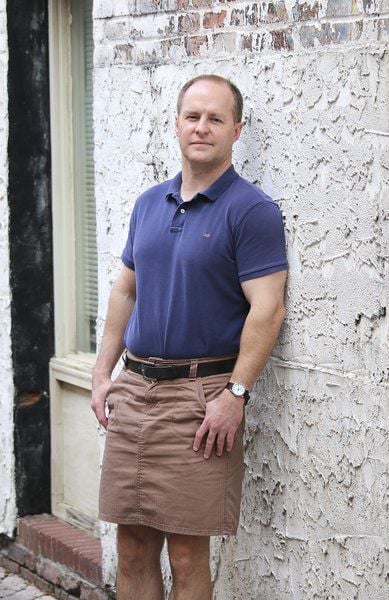
I see skirts as a matter of practicality and equality. It started one roastingly hot July day in 2016 along the 31st parallel in the United States. Elsewhere countless Scotsmen, Japanese, Indonesians, Fijians, Samoans, and roughly one billion Indian and Arab men would agree. The American celebrities Jaden Smith, Marc Jacobs, and Jared Leto regularly wear skirts and skirt-like garments. So I adamantly deny and dispute any notion that skirts are intrinsically feminine. Skirts and tunics are clearly comfortable and the right skirt is plainly practical. One does not wear a tuxedo to the pool nor bermuda shorts to the office. But one can wear a kilt to a wedding and also to the park. Dress codes that deem skirts acceptable for women prove that skirts are acceptable work attire. Period. End of story. That was the argument women used to wear pants to the office.
A few decades ago, the women’s liberation movement argued that gender equality afforded women as much right as men to wear pants in the workplace. Workplaces, in turn, shape the culture of industrialized nations. One example of this is the gender-segregated toilet which appears to have started in 1887 when Massachusetts and New York legislated that employers provide separate toilets for female employees (but whether women were required to use them is less clear). Factory inspectors thereafter frequently included superfluous comments in their reports concerning the adequacy and propriety of women’s facilities, in many cases noting that entrances were not sufficiently hidden from plain view. If this sounds bizarre, it will help to know that this was the height of the Victorian era and it was scandalous for the public to have knowledge that women also answered nature’s call. Many reports also noted an absence or insufficiency of adjoining parlors or “resting rooms” where women could recover their strength when the hustle and bustle of the boisterous modern world so taxed them that they grew faint (of course, fainting had much more to do with their torturous corsets than with the harshness of a big city).
In a 20,000-word essay published in 2007 (cited in comments), Professor Terry Kogan of the University of Utah School of Law argues that gender-segregated toileting is purely a consequence of societal changes during the American industrial revolution (which came later than the European industrial revolution) combined with the lesser-known “sanitarian movement” of the Victorian era. Professor Kogan poignantly suggests that gender-segregated toilets had little (if anything) to do with the anatomical or sexual differences between men and women. Professor Kogan also discusses instances of women-only rail cars and special teller windows for female customers who were presumed to require nuanced hand-holding to complete their transactions. Libraries of the day—previously exclusive to men—created separate entrances leading to separate parlors stocked with separate reading materials deemed appropriate for women. In this way governmental and commercial institutions “played an active role in reproducing a particular set of gender assumptions […] that encouraged female[s] to assume culturally prescribed postures of genteel femininity.” On balance, gender segregation was not only misogynist for regarding women as physically and intellectually inferior, but objectively misandrist for construing all men as mouth-breathing brutes. Since both premises are blatantly incorrect, history thus suggests that gender-segregated spaces functioned primarily as realms to which the men could banish their wives, sisters, mothers, and daughters in order to deny them participation in the evolving society.
I wonder if the same could be said of bifurcated garments (i.e. pants). Though ancient Greek and Roman men found tunics and togas perfectly suitable for daily life, the Olympic games were conducted not in pants, but au naturel (as much for freedom of movement as to exhibit their physiques). Even during the Renaissance, aristocratic men wore tunics of increasingly shorter lengths while the working proletariat labored and toiled in pants. (Interestingly enough, male aristocrats wore open-crotch stockings underneath their tunics which, as hemlines rose higher and higher, led to the use of codpieces.) In terms of human history, the bifurcated pant is a relatively modern contrivance and, at least in the Americas, reflects our social pedigree of pioneering and industrialization that began with the pilgrims and continued through World Word II. Bifurcated garments are more practical for manual labor and they are definitely safer when working around machinery. But now that our society is undeniably characterized by corporate environments, what reason is there for cubicle-confined men to be denied more comfortable attire—especially when our summer temperatures swelter above 100 degrees?
Yes, temperature was the final straw for me that July afternoon when my Camry advised me that the outside temperature had reached 103° F. I went to a thrift store looking for well-worn medical scrubs and instead left with two skirts. Up to that point, each of my prior employers prohibited men and women from wearing shorts, but specifically permitted women to wear pants, skirts, and dresses. While an employer may lawfully prescribe or prohibit certain garments through its dress code, it seemed to me that since skirts were deemed acceptable for the workplace, it would be discriminatory to restrict them exclusively to women (as illustrated by the aforementioned women’s lib movement on pants).
I can tell you that skirts are, generally speaking, far more comfortable than pants. I can also tell you that apart from personal comfort, I intend my skirts to promote a sociopolitical message of equality and acceptance while further condemning appearance-based prejudices like racism, colorism, ageism, sexism, and genderism. But more troubling than these issues is the inherent symbology of power. By this I mean that women who started wearing pants appropriated that style as a power symbol (in other words, since men wore pants, the women who then wore pants symbolically asserted themselves as equal to men, which in no small way explains our social meme of “wear[ing] the pants in the family”). Men, on the other hand, would have diminished their social rank had they adopted the symbol (i.e. skirt) of the socioculturally inferior woman. This construct persists even today (some fifty years later) because since only women continued wearing skirts, society unconsciously concluded that only women should wear skirts. Unfortunately, associating symbols of power with gender proves the existence of an ongoing sociocultural misogyny. Stated more simply, if a skirt socially de-masculinizes a man, then men and women cannot be considered social equals; if they truly were equals, the symbols of one class would not devalue the other.
Personally, I am quite particular in the styles that I wear, and I usually pair them with a strong polo or oxford and various “masculine” accessories (belt, watch, leatherman, etc). If, in light of the previous statements, I sound hypocritical, so be it! The very fact that we perceive and speak of these symbols as “masculine” or “feminine” merely underscores the very real social inequality. I feel no duty to shave my legs and to my knowledge no one mistakes me for a cross-dresser. I sometimes get perplexed smiles and chuckles in public spaces, but nothing that I would consider harassing. I am single and I can still work my mojo. Sure, I have to step up my game, but merely wearing a skirt is not an automatic self-imposed cock-block (and perhaps the skirted male even gains an advantage as a manifestly self-confident person is tremendously more alluring). One time I wore a skirt on an afternoon movie outing and my companion was bothered only by my shirt, not by my skirt! I have even interviewed for jobs in a (work-appropriate) skirt and been hired. It boils down to confidence.
I would like to point out that skirts are functionally superior than pants and shorts. Skirts afford better conduction of heat away from the femoral blood vessels. Better thermoregulation, in turn, reduces perspiration and itching, and improves reproductive system health. Plus, skirts effectively prevent wedgies and plumber butt. In 2009 H&M briefly introduced a line of men’s skirts. Today there is a neat carpenter design available online from Utilikilt as well as a unisex skirt from SkirtCraft. There are commercial lines of male and female running skirts and a growing community of avid backpackers who wear skirts as a hygienic convenience on the trail.
Just because public images depict women in skirts and men in pants does not mean that a man who wears a skirt is automatically a cross-dresser or a sexual deviant. In actuality, gender expression, gender identity, and sexual orientation are all independent variables that comprise a person’s sexual self (but that is a subject for other blog posts). Societal expectations evolve slowly and effecting change takes time, participation, and dialogue. I want to encourage others to give themselves permission to question their sociocultural beliefs. I also invite those who see me in the community to feel at ease approaching me for dialogue.

